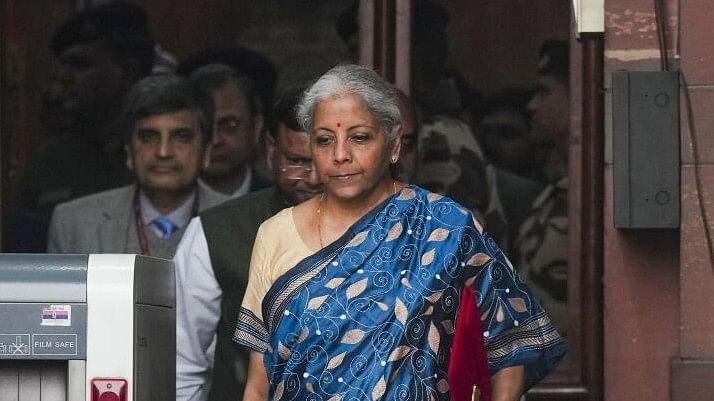
FM Nirmala Sitharaman carrying a folder-case containing the Interim Budget 2024 leaves from Finance Ministry ahead of the presentation of the budget, in New Delhi.
Credit: PTI Photo
The interim budget on February 1 turned out to be one with ‘no spectacular announcements’ as Union finance minister Nirmala Sitharaman had mentioned. Instead, the occasion was used to present the Union government's report card for the last 10 years.
There were high expectations and hype around the budget given the election year, and in the context of the ‘sweet spot’ as analysed by the economists referring to the high tax collection in the current financial year. Sitharaman surprised everyone with the announcement of the targeted fiscal deficit of 5.1 per cent, in contrast to 5.4 per cent as was called by industry leaders in the last fortnight. The budget reflects the ruling Bharatiya Janata Party (BJP)’s confidence in winning the upcoming general elections and thus not upsetting the apple cart.
The budget is not populist, but aims at fiscal consolidation and strengthening of the economy with a lot more fiscal prudence — something that is not expected in a budget so close to the general elections. The interim budget appears to have acknowledged and aligned with the 4.5 per cent fiscal deficit target for 2026, which is the highlight among the messages the budget sends to the market and to international rating agencies.
The market may not be happy with the mere 11 per cent hike in the capex budget as compared to 34 per cent last time. At the same time, announcements such as 200 million more houses under the Pradhan Mantri Awas Yojna-Gramin in five years, pilgrim tourism centres development and long-tenure tourism loans to the states, 40,000 normal rail bogies getting converted to Vande Bharat standards, three railway corridors to decongest and enhance the speed mobility, hike in metro rail budget and mention of the e-buses in the augmentation of the public transport, could satisfy and reassure the markets with what is coming in the full budget in July.
While the subsidies to food, fertiliser, and urea are cut down, the push for the infrastructure allocation continued with the hike in the road, port, and railway sectors. The budget numbers also show that the government has not decided on the continuity and focus on schemes such as the Urban Rejuvenation Mission: AMRUT and Smart Cities Mission, Faster Adoption and Manufacturing of (Hybrid and) Electric Vehicle in India-(FAME) as their numbers are lower this time as compared to the previous year. This gives enough room for a revisit of the schemes and probably a relaunch in the full budget in July.
Perhaps more details towards this can be expected in the BJP’s Lok Sabha election manifesto. It will be interesting to see how UDAN routes attract airline companies and what will be the bidding rounds involved to utilise the 149 airports and 1000-plus new aircraft (which is essentially a private investment) as exuberated by the minister.
While the budget allocation is aligned with the roadmap set by the government, in infrastructure projects, attention must be directed towards curbing cost overruns. This aspect is often overlooked and has historically resulted in increased cost. According to the Ministry of Statistics and Programme Implementation (MoSPI), which oversees infrastructure projects valued at Rs 150 crore and above, 431 out of 1,820 projects reported cost overruns, with 848 projects experiencing delays. The original cost of implementation for these projects was Rs 25.87 lakh-crore, but the anticipated completion cost is projected to reach Rs 30.69 lakh-crore, indicating overall cost overruns of Rs 4.82 lakh-crore. This demands immediate attention on the policy front beyond the budget estimates as it can derail the fiscal deficit targets set out in the budget.
It's evident that the Union government has placed significant emphasis on capital expenditure. Ideally, an increase in capital expenditure also stimulates private investment. However, private investment has remained subdued despite previous years’ heightened focus on capex. One reason for this tepid private investment is attributed to lacklustre demand in the economy.
Private Final Consumption Expenditure (PFCE), which represents expenditure on all goods and services, saw a mere 2 per cent rise in 2023. This is to say that while capital expenditure expansion can potentially encourage private investment, additional factors and conditions might be necessary for this effect to manifest fully.
Let’s hope that the emphasis and focus on schemes directed at women, the poor, youth, and farmers will revive the appetite of the market forces to supplement the sustained growth of the economy more sustainably and inclusively.
(D Dhanuraj is Chairman, and Nissy Solomon is Senior Research Associate, Centre for Public Policy Research, Kochi.)
Disclaimer: The views expressed above are the author's own. They do not necessarily reflect the views of DH.